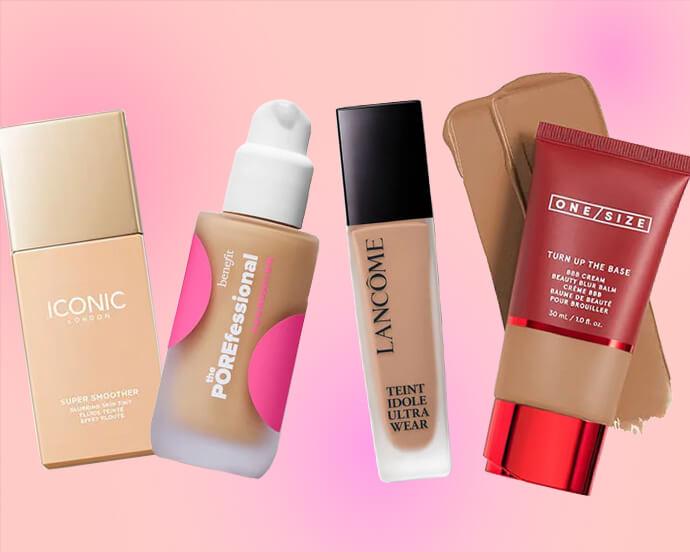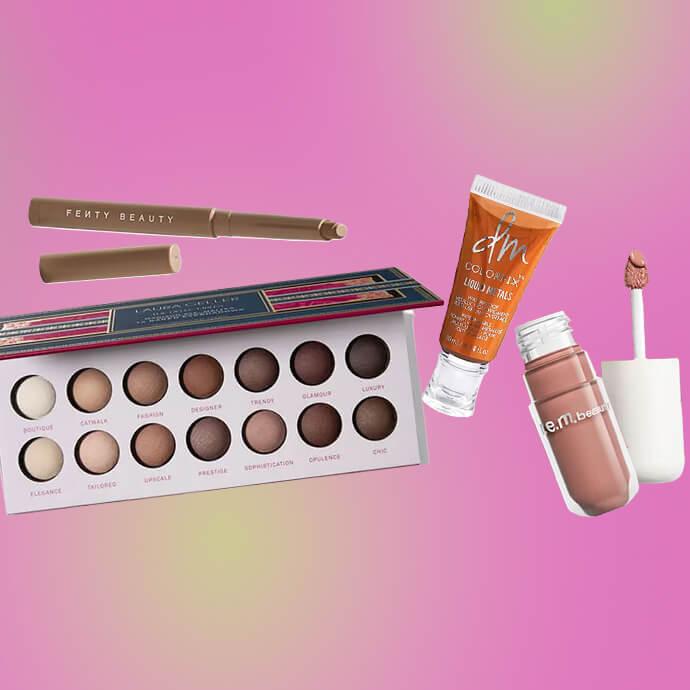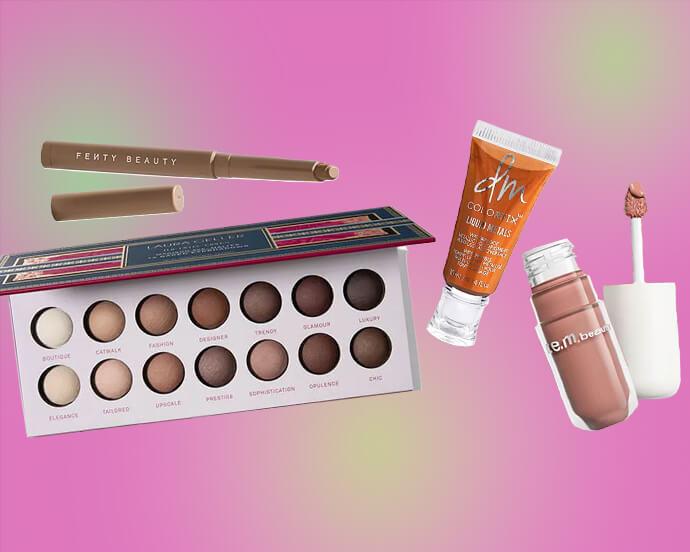9 Tips to Keep Concealer Crease-Free From Pro Makeup Artists



Pia Bhattacharya


There are few makeup products that we have a love/hate relationship with like under-eye concealers (except liquid eyeliner, of course). Don’t get us wrong, we can’t live without the stuff. But after a few hours of wear, it can start creasing, caking, settling into lines, and highlighting exactly what we’re looking to minimize. We’re pretty adventurous when it comes to makeup, but that’s not our idea of a good time. For many of us, under-eye concealer is non-negotiable. From dark circles to uneven skin tone, it’s our go-to to brighten us up and fake a well-rested look after a 1 a.m. TikTok spiral. So when we use concealer, we want it to do its job and we want it to last all day.
So why does our under-eye concealer crease in the first place? We took this question and more to makeup artists Brenna D and Shannon Marie, and they let us know we’re not alone. “Since we move our eyes constantly and the skin underneath is so thin, the best formulas to minimize creasing are thin, but pigmented. However, it’s important to remember that makeup moves because our face moves.” Brenna D adds, “To keep it 100%, I want to note that even the most perfect makeup application may result in shifting or creasing. Skin is alive and it moves and adapts its temperature regularly. There are many tips and tricks that could help you with feeling confident in your makeup all night but, it’s important to be realistic.”
So, in a nutshell, concealer creasing happens to the best of us—and it’s totally normal. But, there areways to help keep it under control. Read on for nine pro tips on keeping your concealer looking fresh, smooth, and crease-free for hours on end.


It's about glam time you treated yourself.
MEET THE EXPERT
Brenna D is a makeup artist, hair stylist, and groomer based in New York City.
Shannon Marie is a film and television makeup artist based in Los Angeles.
How to Prevent Concealer From Creasing Under Eyes
1. Start with skincare.
Like all makeup prep, skincare matters and hydration is key. Starting with well-moisturized under-eyes will help concealer go on smoothly, spread evenly, and prevent it from creasing and looking cakey (especially if you have dry skin or mature skin). “Makeup only looks as good as the surface it’s sitting on so always focus on your skin first,” says Brenna D. “Eye serums, creams, and massaging can minimize the appearance of fine lines, dryness, puffiness, and dark circles. Although some products can have an instant effect, being consistent with a skincare routine, having a healthy diet, and drinking water can improve your base.”
When applying skincare, don’t be too heavy-handed. Brenna D says, “Let your eye cream or serum absorb for at least 10 minutes before applying your makeup. If skincare mixes with concealer, it can become slippery. If you are concealing or color correcting your eyelids, avoid applying heavy cream in that area.”
Shannon Marie adds, “One of my favorite products to prep the under-eye for concealer is the BELIF First Aid 360 Eye Care Mask (an intensely moisturizing eye cream). It has a bouncy texture that hydrates, plumps, and feels so refreshing! I apply a thin layer, wait a minute or two, and the remaining residue leaves a perfect tacky base to lock in concealer and keep the area hydrated.”
2. Choose the right concealer formula.
With concealer, choosing the right texture is key to achieving a crease-free finish. Whether you like creamy concealers or liquids, it’s important to find a formula that suits your skin type. Shannon Marie says, “I like to have a couple of concealer formulas on hand to do different tasks. I love using a light-reflecting concealer for the under-eyes to brighten and soften, and a matte concealer to lock on to stubborn blemishes.”
Also, try to opt for something with a light texture over a heavier, full-coverage concealer. If you’re concerned about coverage, you can still achieve it (more on that further below). Lightweight concealers are more flexible and less likely to settle into creases. Brenna D notes that how you use your concealer is just as important, and should be intentional. “Avoid placing concealer, especially a lighter shade, all over if you are trying to camouflage any puffiness. This will highlight any raised areas. Avoid adding layers of concealer to dark circles without color correcting, and avoid putting concealer on “just because.”
3. Remember that placement is key.
We’ve seen so many ways to apply under-eye concealer—from the upside-down-triangle method to just on the inner and outer corners of the eye. How you apply concealer depends on the level of coverage you’re seeking, your skin texture and type, and more. Breanna D breaks it down for us here:
For Lifting And Brightening: Apply to the inner corner and outer corner of the eye
For Camouflaging Bags: Apply only to the shadow (sunken area) with a thin brush to adjust dimension
For Dark Circles: Apply a small amount of color corrector to the area you want to cancel out darkness (a product that dries down is best to prevent sliding or mixing). Tap the concealer that matches your skin tone on top, and avoid using a wiping motion when you blend.
For Fine Lines: Apply a small amount at a time, build product as needed.
There’s one universale rule when it comes to preventing creasing: Don’t apply concealer directly onto your lower lash line. The delicate skin in this area is thin, and can’t hold as much product as the rest of your face.
4. Build coverage in layers.
How you apply your concealer is just as important as what formula you use, and even the best concealers will crease if you don’t apply them correctly. To minimize concealer creasing, layering on your concealer is the way to go. “Apply concealer one layer at a time, and take a step back in the mirror after each layer to look at the whole picture. No one is looking at your face as close as you are! I love using a flat small brush to press in color and a fluffy brush to lightly remove excess product and diffuse the edges,” says Shannon Marie.
5. Cover fine lines and wrinkles.
Preventing concealer from settling into fine lines and wrinkles can be tricky. Brenna D says, “Using a fluffier brush to blend out concealer is one of my favorite tips for fine lines and wrinkles. I apply the product to a palette and, using a sweeping motion, take a little of the product with my Cozzette D240 Fusion Brush to dust on as needed. Then, I take a clean fluffy brush to buff and blend the product as desired.” She adds, “Applying the product to a palette or the back of your hand gives you control over how much a product you are using and where it goes. I especially love this when using my buffing technique on fine lines and wrinkles to warm up the product.”
6. Blot before setting.
Just like you blot your lipsticks for better coverage and smooth results, blotting your concealer can help create an even finish to minimize creasing. Once you’ve applied your concealer and blended it out, take a sheet of your go-to blotting paper and gently press it on your under-eye area, over your concealer. This will help any excess product or lingering oils from settling into fine lines and creases for a more flawless finish overall. Keep blotting papers handy for touch-ups when you’re on the go.
7. Set with powder.
Before you reach for setting powder, Brenna D says to let things settle. “Apply powder last to give the concealer a few minutes to settle. That way you’ll be able to see if you need to take some off before powdering. I use an ultra fine q-tip to remove any extra product lines, then blend it out. When you’re ready to set, she says, “Make sure the area is blended out before setting. Any concealer lines that are visible will be “cemented” in with powder. Then, tap or roll a fluffy brush over the area you applied concealer. Because they are finely milled, my favorite powders to set concealer are Laura Mercier Translucent Loose Setting Powder, Charlotte Tilbury Airbrush Flawless Finish, and Danessa Myricks Evolution Setting Powder.”
8. Try baking.
Another method we love for major staying power? Light baking. Not the heavy-handed powder application you’re used to associating with the term—but the same technique using only a light dusting of powder. Make sure your concealer is blended smoothly, then apply setting powder with a makeup sponge, powder brush, or setting brush. Let the powder sit while you finish your makeup for at least 5 to 10 minutes. This helps absorb any oils and really locks your concealer in. Then, gently dust it all off. If you see shiny spots throughout the day, go in with a super light dusting of powder to soak it up and re-set your concealer.
9. Apply concealer last.
We’re used to applying our concealer early on in our makeup routines. But Shannon Marie’s tip is based on the idea that less concealer will lead to less creasing. Makes sense, right? Shannon Marie says, “One of my favorite tips for concealer is to apply it last in your makeup routine. You typically don’t need as much as you think you do, and oftentimes a cheek color or eyeliner shade choice will distract from darkness underneath the eye. The less product you apply the less creasing you’ll have.”
Want more tips to apply your makeup products flawlessly? Take our Beauty Quiz now to get started. Already an Ipster? Refer your friends to earn points, which you can use toward products. Either way, don’t forget to check us out on Instagram and Twitter @IPSY.
Like this article? Share it with your friends by clicking the icons below!
Liked this post? Share!
Related Stories


Makeup
Want an IRL Filter? These Are the Best Blurring Foundations
Published on Dec 12, 2025 • 5 min read


Makeup
How to Expertly Apply Eyeshadow on Mature Skin
Published on Dec 10, 2025 • 6 min read


Makeup
How to Use Bronzer and Contour to Sculpt Your Face Like a Pro
Published on Dec 5, 2025 • 9 min read


Makeup
Makeup for Older Women That Works With Your Skin, Not Against It
Published on Dec 1, 2025 • 12 min read


Makeup
2026’s Biggest Makeup Trends Are a Maximalist Dream
Published on Dec 1, 2025 • 8 min read


Makeup
2025’s Biggest Makeup Trends: Go Big or Go Home
Published on Dec 13, 2024 • 7 min read


Makeup
16 New Year’s Eve Makeup Ideas to Fashionably Ring in 2026
Published on Nov 25, 2025 • 10 min read


Makeup
Your 2026 Beauty Horoscope Is Here—and the Stars Are Serving Looks
Published on Nov 25, 2025 • 9 min read


Beauty Picked Just for You
Get 5 products worth up to $70
Plus exclusive access to epic deals up to 80% off
Starting at just $14/month. Cancel anytime.